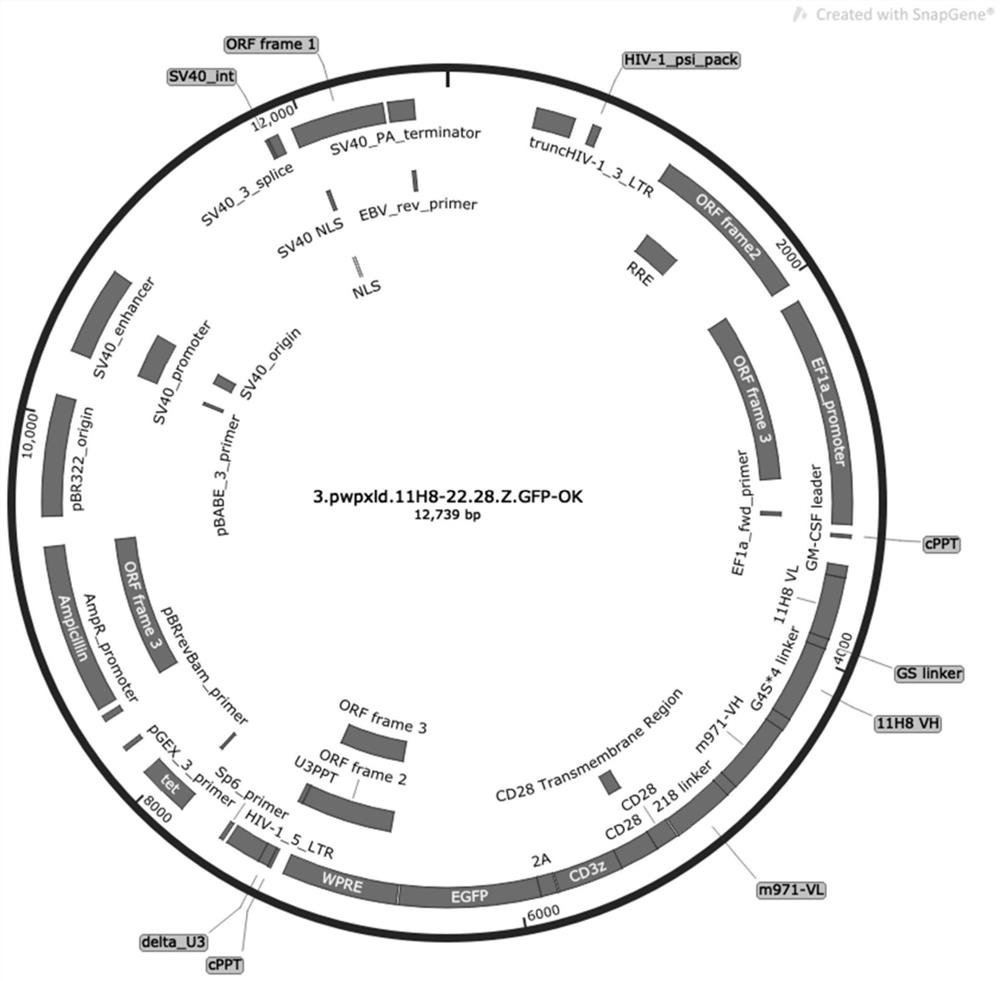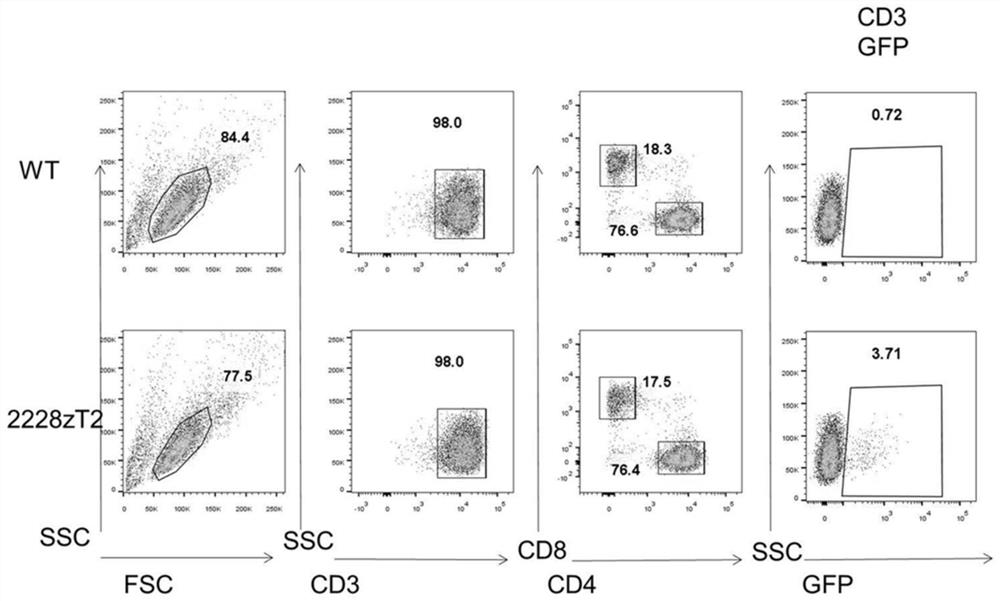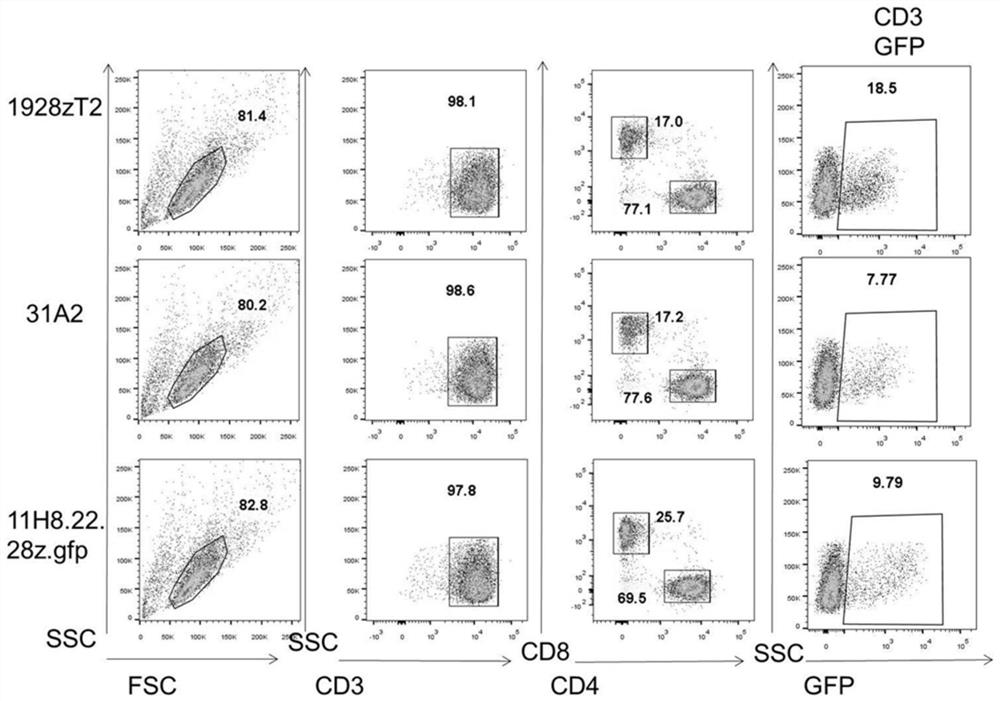CD19 and CD22 double-target chimeric antigen receptor and application thereof
A technology of chimeric antigen receptors and antigens, applied in the field of biomedicine, can solve problems such as poor efficacy and tumor recurrence in patients
- Summary
- Abstract
- Description
- Claims
- Application Information
AI Technical Summary
Problems solved by technology
Method used
Image
Examples
Embodiment 1
[0105] Example 1 Construction of CAR molecular vector
[0106] This example firstly synthesizes the coding gene of the anti-CD19 and CD22 dual target chimeric antigen receptor, and adds the restriction endonuclease Pme1 restriction site and its protective base and its protective base to the C-terminal and N-terminal of the coding gene. Restriction endonuclease Spe1 restriction site and its protective base;
[0107] The coding gene was double digested with restriction enzymes Pme1 and Spe1, and the digested product containing sticky ends was recovered by agarose gel electrophoresis, and ligated into the linearized pWPXLd-eGFP plasmid (containing the same double digestion with Pme1 and Spe1). In the sticky end), the ligation reaction was carried out with the participation of T4 DNA polymerase (Invitrogent) to obtain a lentiviral vector containing CAR coding genes targeting CD19 and CD22 dual targets. The map is as follows figure 1 Shown.
[0108] In this example, the anti-CD19 scFv CA...
Embodiment 2
[0109] Example 2 Lentivirus packaging
[0110] In order to introduce CAR molecules into T cells, 293T cells are used to prepare recombinant lentivirus. When the 293T cells are spread on a 100mm culture dish to 80-90% of the bottom, the lentivirus is packaged:
[0111] 2h before virus packaging, change the medium to DMEM containing 1% fetal bovine serum, and add 6mL / 100mm petri dish;
[0112] Prepare the plasmid mixture as shown in Table 1. The pWPXLd-expression plasmid includes a lentiviral vector containing a CAR encoding gene targeting CD19 and CD22 dual targets, and a lentivirus containing a CAR encoding gene targeting CD19 single target Vectors, lentiviral vectors containing CAR encoding genes targeting CD22 single target, pWPXLd-eGFP plasmid is an empty vector without CAR encoding genes;
[0113] Table 1
[0114]
[0115] Add 36μg PEI to another 500μL opti-MEM medium, mix well, and let stand for 5min at room temperature;
[0116] Mix the pWPXLd-expression plasmid or pWPXLd-eGFP pla...
Embodiment 3
[0121] Example 3 T cell activation and lentiviral transfection
[0122] Use Ficoll density gradient centrifugation kit (GE) to separate peripheral blood mononuclear cells (PBMC) from whole blood, remove red blood cells, and then use MACS Pan-T magnetic beads to sort out T cells;
[0123] The sorted T cells are diluted with medium (AIM-V medium + 5% FBS + penicillin 100 U / mL + streptomycin 0.1 mg / mL) to a cell concentration of 2.5×10 6 Pieces / mL to be used;
[0124] Use CD2 / CD3 / CD28 T cell activation amplification kit (Miltenyi) to activate T cells, that is, the coated magnetic beads are mixed with T cells in a ratio of 1:2, and the final density of T cells is 5×10 6 Piece / mL / cm 2 , After mixing, place at 37℃, 5% CO 2 Incubate for 48h;
[0125] After T cells are activated for 48 hours, demagnetize the beads, centrifuge at 300g for 5 minutes, remove the supernatant, resuspend the T cells in fresh medium, add recombinant lentivirus expressing CAR or blank control eGFP lentivirus (MOI=10),...
PUM
 Login to View More
Login to View More Abstract
Description
Claims
Application Information
 Login to View More
Login to View More - R&D
- Intellectual Property
- Life Sciences
- Materials
- Tech Scout
- Unparalleled Data Quality
- Higher Quality Content
- 60% Fewer Hallucinations
Browse by: Latest US Patents, China's latest patents, Technical Efficacy Thesaurus, Application Domain, Technology Topic, Popular Technical Reports.
© 2025 PatSnap. All rights reserved.Legal|Privacy policy|Modern Slavery Act Transparency Statement|Sitemap|About US| Contact US: help@patsnap.com



